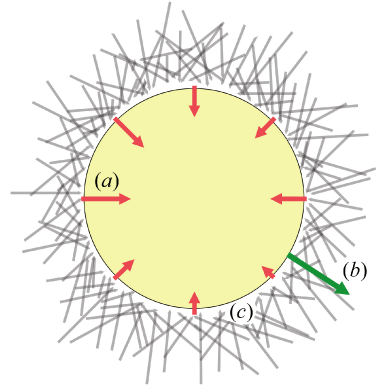- "Cooperative
symmetry-breaking by actin filament polymerization in a model for
cell motility"
-
Figure 1. Symmetry-breaking in a cloud of actin filaments
-
Symmetry Breaking

(a) Polymerizing actin exerts force on bead [g(Ω,t): effective force/actin density]
(b) Net force pushes bead
(c) Actin dynamics influenced by local velocity of bead surface
Eliminating fast modes leads to an effective (stochastic) equation for the velocity:
"Phase diagram and critical behavior" (noiseless):
Nonspherical Beads:
- Instability is typically along the direction offering the largest cross-sectional view,
- M. F. Carlier et al, BioEssays 25, 336 (2003)
- Singularities are determined by bead symmetries: